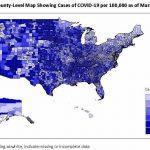By Shelby Ruud
A new study from the Western Rural Development Center (WRDC) based at Utah State University shows a connection between political views and COVID-19 per capita cases and death rates.
The article, “COVID-19 in Rural America: Impacts of Politics and Disadvantages,” shared information from the study showing that counties with high percentages of Donald Trump voters had higher per-capita cases of COVID-19.
“The COVID-19 pandemic has had severe negative health and economic impacts throughout the country,” said Don Albrecht, executive director of the WRDC and author of the study. “After 18 months, we are still struggling. This article makes it clear that during a pandemic, political views have consequences. This past summer, failure to follow the advice of medical experts has resulted in a surge of people unnecessarily becoming ill, pushing hospitals and their staffs to their breaking point. Despite new medications that provide some relief for the severely ill, death still takes a daily toll in the United States.”
While political views were the most important variable explaining per capita COVID-19 cases, measures of disadvantage, such as low levels of education and high levels of poverty, were the best predictors of COVID-19 deaths.
“My goal in conducting this research was to better understand factors that explain where COVID-19 pandemic impacts were more and less severe,” Albrecht said. “I hope that recognition of the role of political views as well as the continued need to provide adequate medical care will help elected officials make appropriate policies and individuals make better choices.”
The WRDC focuses on science-based research and educational outreach capacity with communities, local decision-makers, entrepreneurs, families, farmers and ranchers to help address a wide range of development issues. While located at Utah State University, the WRDC works with partners to address the community and economic development concerns of the residents and communities in 13 western states.
The article was published in August 2021 in the academic journal, Rural Sociology. The study can be found here.



